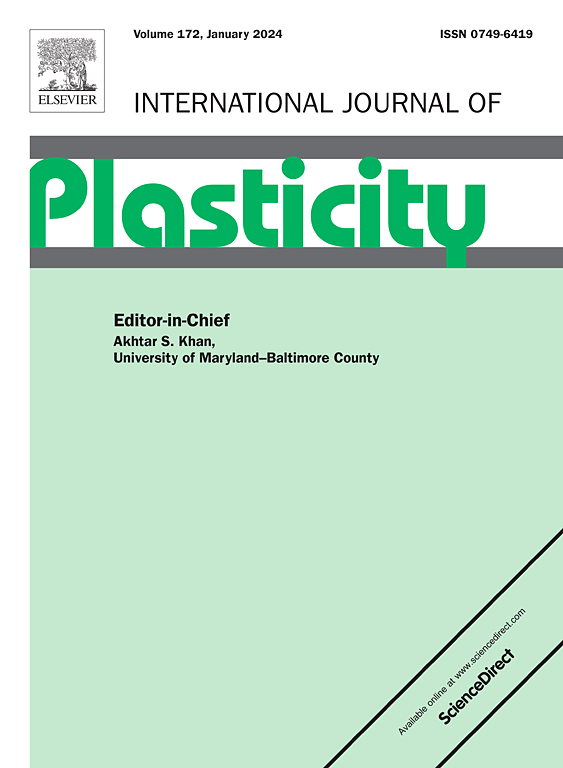Lüders band-assisted high uniform ductility in ultrastrong ferrous medium-entropy alloy via hierarchical microstructure
IF 12.8
1区 材料科学
Q1 ENGINEERING, MECHANICAL
引用次数: 0
Abstract
In this work, we harness a hierarchical microstructure to tailor both the strengthening and deformation mechanisms of Co21Cr12.5Fe55Ni4Mo7.5 (at %) ferrous medium-entropy alloy (MEA) simultaneously. A simple thermomechanical processing (cold rolling and 90 s of annealing) creates a hierarchical microstructure composed of ultrafine recrystallized grains, non-recrystallized grains with rolling-driven substructures, and intragranular nanoprecipitates. The hierarchical microstructure with the high density of dislocations and ultrafine recrystallized grains leads to a high yield strength of ∼1.60 GPa, but it is well-known that the same features can make materials vulnerable to premature fracture. To solve this issue, Lüders deformation, which was induced by the ultrafine grain boundaries and stress-induced martensitic transformation facilitated by pre-existing martensite nucleation sites, was harnessed: stable propagation of the Lüders band delays massive strain hardening by regulating strain-induced martensitic deformation that ensues and enables a large uniform ductility. Resultantly, tensile strength of ∼1.84 GPa and uniform elongation of ∼20 % are achieved, on par with the finest tensile properties among multi-principal element alloys ever reported. Our results point to a paradigm to achieve a large uniform ductility via harnessing the Lüders deformation without compromising strength, based on the hierarchical microstructure.

基于分层显微组织的 ders波段辅助的超强亚铁中熵合金的高均匀塑性
在这项工作中,我们利用分层显微结构同时定制Co21Cr12.5Fe55Ni4Mo7.5 (at%)亚铁中熵合金(MEA)的强化和变形机制。简单的热机械处理(冷轧和90秒的退火)产生了由超细再结晶晶粒、具有轧制驱动亚结构的非再结晶晶粒和颗粒内纳米沉淀组成的分层微观结构。具有高密度位错和超细再结晶晶粒的分层微观结构导致了高达1.60 GPa的屈服强度,但众所周知,同样的特征也会使材料容易过早断裂。为了解决这一问题,利用了由超细晶界和马氏体成核区促进的应力诱导马氏体转变引起的l ders变形:l ders带的稳定扩展通过调节应变诱导马氏体变形来延迟大量应变硬化,从而实现了大的均匀延展性。结果,达到了1.84 GPa的抗拉强度和20%的均匀伸长率,与迄今为止报道的多主元素合金中最好的抗拉性能相当。我们的研究结果指出了一种范例,通过利用 ders变形而不影响强度,实现基于分层微观结构的大均匀延展性。
本文章由计算机程序翻译,如有差异,请以英文原文为准。
求助全文
约1分钟内获得全文
求助全文
来源期刊

International Journal of Plasticity
工程技术-材料科学:综合
CiteScore
15.30
自引率
26.50%
发文量
256
审稿时长
46 days
期刊介绍:
International Journal of Plasticity aims to present original research encompassing all facets of plastic deformation, damage, and fracture behavior in both isotropic and anisotropic solids. This includes exploring the thermodynamics of plasticity and fracture, continuum theory, and macroscopic as well as microscopic phenomena.
Topics of interest span the plastic behavior of single crystals and polycrystalline metals, ceramics, rocks, soils, composites, nanocrystalline and microelectronics materials, shape memory alloys, ferroelectric ceramics, thin films, and polymers. Additionally, the journal covers plasticity aspects of failure and fracture mechanics. Contributions involving significant experimental, numerical, or theoretical advancements that enhance the understanding of the plastic behavior of solids are particularly valued. Papers addressing the modeling of finite nonlinear elastic deformation, bearing similarities to the modeling of plastic deformation, are also welcomed.
 求助内容:
求助内容: 应助结果提醒方式:
应助结果提醒方式:


